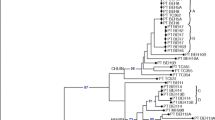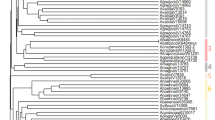Abstract
O. tuberosa is an Andean crop that belongs to the worldwide distributed genusOxalis. On the basis of their chromosome numbers the following species (O. herrerae, O. lotoides, O. medicaginea, O. mollissima, O. oblongiformis, O. peduncularis, O. spiralis, O. subintegra, O. tabaconanensis, O. tuberosa, O. villosula) were placed in an alliance. To analyse five species belonging to theOxalis tuberosa alliance (O. oblongiformis, O. peduncularis, O. tabaconanensis, O. tuberosa andO. villosula) and a distant member of the genus (O. articulata), we examined 253 AFLP markers generated after amplification using four primer combinations. Within the alliance, two main clusters were observed, one containing the diploid species and the other group with the polyploid speciesO. tuberosa. All of the primer combinations assayed showed the same clustering pattern. Grouping of accessions of each species by data analysis corresponded largely with their previous taxonomic classifications. The concordance between the clustering of the individuals belonging to different species obtained in this work show the appropriateness of AFLP markers for this type of study. The results obtained are in good agreement with the cytogenetic hypothesis and showed a clustering behaviour, which is similar to the one previously obtained using ITS rDNA nucleotide sequence comparison.
Similar content being viewed by others
References
Ajmone Marsan P., Catiglioni P., Fusari F., Kuiper M., Motto M. (1998) Genetic diversity and its relationship to hybrid performance in maize as revealed by RFLP and AFLP markers. Theor. Appl. Genet. 96: 219–227.
Besse P., Taylor G., Carroll B., Berding N., Burner D., McIntyre C. L. (1998) Assessing genetic diversity in a sugarcane germplasm collection using an automated AFLP analysis. Genetica 104: 143–153.
Cárdenas M. (1969) Manual de plantas económicas de Bolivia. Cochabamba: Imprenta Icthus.
Cronquist A. (1981) An integrated system of classification of flowering plants. Colombia University Press, New York, NY.
de Azkue D. (1986) Origen de la variación del cariotipo en especies sudamericanas deOxalis. Tesis de Doctorado. Facultad de Cs. Exactas y Naturales Universidad de Buenos Aires, Argentina.
de Azkue D., Martínez A. (1983) The Chromosome Complements of shrubbyOxalis species from South America. Plant Syst. Evol. 141: 187–197.
de Azkue D., Martínez A. (1984) Variación en el cariotipo, volumen nuclear y contenido de ADN en 7 especies afines deOxalis. Darwiniana 25 (1–4): 267–277.
de Azkue D., Martínez A. (1989) DNA content and chromosome evolution in the ShrubbyOxalis. Genome 30 (1): 52–57.
de Azkue D., Martínez A. (1990) Chromosome Numbers of theOxalis tuberosa aliance (Oxalidaceae). Plant Syst. Evol. 169: 25–29.
Dellaporta S. L. (1983) Plant DNA minipreparation: version II. Plant Mol. Biol. Rep. 1: 19–21.
Denton M. F. (1973) A Monograph ofOxalis, sectionInoxalis (Oxalidaceae) in North America. Publications of the Michigan State University Museum, Biological Series 4: 455–615.
Dubcovsky J., Dvorak J. (1995) Ribosomal RNA multigene loci: nomads of the Triticeae genomes. Genetics 140: 1367–1377.
Eiten G. (1963) Taxonomy and regional variation ofOxalis sect.Corniculatae 1. Introduction, keys and synopsis of the species. Amer. Midl. Nat. 69: 257–309.
Ellis R. P., McNicol J. W., Baird E., Booth A., Lawrence P., Thomas B., Powell W. (1997) The use of AFLPs to examine genetic relatedness in barley. Mol. Breed. 3: 359–369.
Emshwiller E., Doyle J. J. (1998) Origins of domestication and polyploidy in oca (Oxalis tuberosa: Oxalidaceae): nrDNA ITS data. Amer. J. Bot. 85: 975–985.
Emshwiller E., Doyle J. J. (1999) Chloroplast-Expressed Glutamine Synthetase (ncpGS): Potential Utility for Phylogenetic Studies with an Example fromOxalis (Oxalidaceae). Mol. Phylogenet. Evol. 12(3): 310–319.
Hill M., Witsenboer H., Zabeau M., Vos P., Kesseli R., Michelmore R. (1996) PCR-based fingerprinting using AFLPs as a tool for studying genetic relationships inLactuca spp. Theor. Appl. Genet. 93: 1202–1210.
Hodge W. H. (1951) Three native tuber foods of the high Andes. Econ. Bot. 5: 185–201.
King S. R. (1987) Four endemic andean tuber crops: promising food resources for agricultural diversification. Mountain Res. Dev. 7: 43–52.
Knuth R. (1930) Oxalidaceae. In: Engler A. (ed.) Das Pflanzenreich 4: 130–131, Leipzig.
Knuth R. (1935) Oxalidaceae 2. Repertorium Specierum Novarum Regni Vegetabilis 38: 194–199.
Knuth R. (1936) Oxalidaceae 3. Repertorium Specierum Novarum Regni Vegetabilis 40: 289–293.
León J. (1964) Plantas alimenticias andinas. Instituto Interamericano de Ciencias Agricólas. Boletín Técnico No. 6 Inst. Interam. de Ciencias Agric., Lima, Perú.
Lourteig A. (1983) Oxalidaceae. Fl. Il. Catarinense 1 (fasc. OXAL): 1–174. R. Reitz, Sta. Catarina Brasil.
Macbride J. F. (1949) Oxalidaceae 1. Oxalis L. Field Museum of Natural History, Bot. Series 13: 544–608.
Mackill D. T., Zhang Z., Redona E. D., Colowit P. M. C. (1996) Level of polymorphism and genetic mapping of AFLP markers in Rice. Genome 39: 969–977.
Marcucci-Poltri S. (1998) Caracterización molecular y cariotípica de la variabilidad genética de germoplasma argentino enSolanum L. Tesis de Doctorado. Facultad de Cs. Exactas y Naturales, Universidad de Buenos Aires, Argentina.
Marks G. E. (1956) Chromosome numbers in the genusOxalis. New Phytol. 55: 120–129.
Maughan P. J., Maroof M. A. S., Buss G. R., Huestis G. M. (1996) Amplified fragment length polymorphism (AFLP) in soybean: species diversity inheritance and near-isogenic line analysis. Theor. Appl. Genet. 93: 392–401.
Naranjo C., Mola L. M., Pogio L., Mulgura de Romero M. (1982) Estudios citotaxonómicos y evolutivos en especies herbáceas sudamericanas deOxalis (Oxalidaceae). I Bol. Soc. Arg. Bot. 20 (3–4): 183–200.
Pakniyat H., Powell W., Baird E., Handley L. L., Robinson D., Scrimgeour C. M., Nevo E., Hackett C. A., Caligari P. D. S., Forster B. P. (1997) AFLP variation in wild barley (Hordeum spontaneum C. Koch) with reference to salt tolerance and associated site-of-origin eco-geography. Genome 40: 332–341.
Paul S., Wachira F. N., Powell W., Waugh R. (1997) Diversity and genetic diferentiation among populations of Indian and Kenyan tea (Camellia sinensis L.) revealed by AFLP markers. Theor. Appl. Genet. 94: 255–263.
Perera L., Russell J. R., Provan J., McNicol J. W., Powell W. (1998) Evaluating genetic relationships between indigenous coconut (Cocos nucifera L.) accessions from Sri Lanka by means of AFLP profiling. Theor. Appl. Genet. 96: 545–550.
Powell W., Morgante M., Andre C., Hanafey M., Vogel J., Tingey S., Rafalski A. (1996) The comparison of RFLP, RAPD, AFLP and SSR (microsatellite) markers for germplasm analysis. Mol. Breed. 3: 225–238.
Roa A. C., Maya M. M., Duque M. C., Tohme J., Allem A. C., Bonierbale M. W. (1997) AFLP analysis of relationships among cassava and otherManithot species. Theor. Appl. Genet. 95: 741–750.
Rohlf F. J. (1994) NTSYS-pc: Numerical Taxonomy and Multivariate System, version 2.01. Exeter Software, Setauket, New York.
Salter T. M. (1944) The genusOxalis in South Africa, a taxonomic revision. Journal of South African Botany (Suppl. 1): 1–355.
Sambrook J., Fritsch E. F., Maniatis T. (1989) Molecular Cloning, a Laboratory Manual. Cold Spring Harbor Laboratory Press.
Sneath P. H. A., Sokal R. R. (1973) Numerical taxonomy. Freeman, San Francisco, California.
Tosto D. S., Hopp H. E. (1996) Sequence analysis of the 5.8S ribosomal DNA and internal transcribed spacers (ITS1 and ITS2) from five species of theOxalis tuberosa alliance. DNA Sequence 6: 361–364.
Tosto D. S., Hopp H. E. (1997) Análisis del espaciador externo de los genes ribosómicos en distintas especies del géneroOxalis. Proceedings of the XXVIII Congreso Argentino de Genética, Tucumán, Argentina.
Tosto D. S., Hopp H. E. (1998) Molecular Evolution of the Andean Crop,Oxalis tuberosa. Proceedings of REDBIO' 98, Tercer Encuentro Latinoamericano de Biotecnología Vegetal. La Habana, Cuba, pp. 257.
Vietmeyer N. D. (1986) Lesser known plants of potential use in agriculture and forestry. Science 232: 1379–1384.
Vos P., Hogers R., Bleeker M., Reljans M., van de Lee T., Hornes M., Frijters A., Pot J., Peleman J., Kuiper M., Zabeau M. (1995) AFLP: a new technique for DNA fingerprinting. Nucleic Acids Res. 21: 4407–4414.
Zhu J., Gale M. D., Quarrie S., Jackson M. Y., Bryan G. J. (1998) AFLP markers for the study of rice biodiversity. Theor. Appl. Genet. 96: 602–611.
Author information
Authors and Affiliations
Corresponding authors
Rights and permissions
About this article
Cite this article
Tosto, D.S., Hopp, H.E. Suitability of AFLP markers for the study of genomic relationships within theOxalis tuberosa alliance. Pl Syst Evol 223, 201–209 (2000). https://doi.org/10.1007/BF00985279
Received:
Accepted:
Issue Date:
DOI: https://doi.org/10.1007/BF00985279




